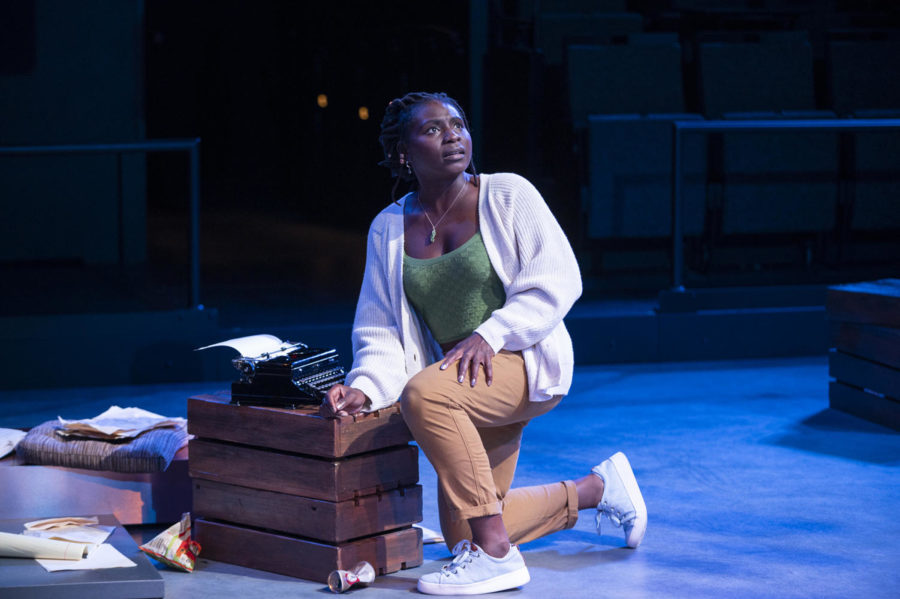1919 adapts speculative poetry for the stage—exploring Black Chicago’s resistance and the events of Red Summer at Steppenwolf Theatre.
Published in 2019 by University of Chicago sociology professor and poet Dr. Eve Ewing, 1919 explores the death of Eugene Williams and the events that led up to Chicago’s Red Summer—the 13-day riot that left Chicago forever changed. Red Summer was sparked by the murder of a 17-year-old Black teenager named Eugene Williams on July 27, 1919. While swimming in Lake Michigan, Williams drifted across an invisible color line and near an unofficial white-only beach near 29th Street. A group of white beachgoers threw rocks at the young man until he drowned. After Williams’s death, Black crowds gathered at the 29th Street beach and demanded the arrest of those responsible, but police officers refused to make an arrest. When a Black man named James Crawford fired a gun, the officers there returned fire and killed him.
Within hours, a deadly riot spontaneously erupted in Chicago. White ethnic street gangs, often part of athletic clubs near Chicago’s “Black Belt”—the area in which African Americans were historically limited to living in on Chicago’s South Side—attacked Black people in street cars and burned down homes in their communities. As Black Chicagoans fought in self-defense, much of the violence committed against them would go ignored by the police. Illinois eventually called the state militia to restore order, but when the dust had settled, 38 lives were lost and hundreds of people were injured. Chicago was not the only city that experienced a Red Summer; similar riots had broken out in Washington, D.C, Houston, Charleston, and more than two dozen other cities across the United States.
1919 first came to life when Ewing first stumbled across a 1922 report titled “The Negro in Chicago: A Study of Race Relations and a Race Riot” by the Chicago Commission on Race Relations during her academic research. Initiated by Illinois Governor Frank O. Lowden, the commission published a 672-page report investigating what led up to the riots, how race relations festered in an informally segregated city like Chicago, and what the aftermath of the riots looked like. Each poem in 1919 is in conversation with this report—navigating the Great Migration, the formation of the city’s segregated “Black Belt” and the underlying tensions and violence that would erupt that day. 1919 ventures far into the imaginative, resurrecting voices from the Commission and imagined first-person survivors of Red Summer.
As the lights flicked off at Steppenwolf, I sat with the one question I had going into the play: how does one adapt a poetry collection as experimental and historically rooted as 1919 into a play? How would playwright J. Nicole Brooks continue the jump from a lyrical policy report to poetry to the stage?
1919 begins with the story of a nameless writer, who is presumed to be Ewing, behind on her deadlines and singularly obsessed with a 1922 report about the Red Summer riots. The writer struggles away at an old-fashioned typewriter propped up on one side of the theater, surrounded by strewn chip bags and documents on the floor. Five other characters abruptly burst on stage from the aisles with jokes and advice for the writer. These six characters, named in the play guide only as Humans One to Six—act as muses, ancestors, cousins, and “what if companions”—examining what could have happened the day of the murder and before to create a racial divide in the Lake. All six tell the story of the riots—struggling as they do it, sometimes breaking the fourth wall—so that the scholar doesn’t have to do it alone.

Punctuated by the ticktack of a trusty typewriter, Humans One to Six tap in and out like a multi-voiced choir, bringing the poems to life in new and innovative ways. 1919 has a penchant for time travel, using the vivid and fantastical to bridge past, present, and future. Electric blue bottles packed with string lights are scattered across the stage, and some descend from the ceiling as the story progresses. Suspended in the air, the bottles put the audience into a time machine. 1919 is an Afrofuturist play that is just as concerned with critically examining the present as it is with considering the past. Its jumps in time work to bridge Chicago’s race riots to more modern events, such as Chicago’s deadly heat wave of 1995, where poor, Black, and elderly residents disproportionately lost their lives, or the day of the Jason Van Dyke verdict in 2018, when police warned people of potential rioting from activists and organizers. During the play, a grave is erected for Eugene Williams, the young teenager who, in reality, didn’t receive a grave marker until 2021, some 102 years after his death. Ending with the poem “I saw Emmett Till this week at the grocery store,” 1919’s actors superimpose the past on the present, creating these tense and sorrowful moments for those who died. Scenes play out with 1919’s narrators asking the audience: how can we dare to dream if we don’t acknowledge the nightmare of what happened here?
The question asked to the audience at the beginning and end of the play is always simple: “who benefits from your unknowing?” It is what starts the play and the post-show discussion that accompany these performances. 1919 is part of Steppenwolf for Young Adult’s offerings this year. For the teenagers who have been the central audience, 1919 is a teaching tool just as much as captive storytelling. Following performances at Steppenwolf, 1919 went on a week-long tour across Chicago as part of the Chicago Park District’s “Night Out in the Parks” program. With pre-performance workshops and post-event discussions at each event, 1919 offers young people a new way to grapple with how racism and segregation have shaped Chicago’s past, present, and future.









